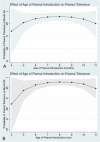LEAPing through the looking glass: secondary analysis of the effect of skin test size and age of introduction on peanut tolerance after early peanut introduction
- PMID: 27896827
- PMCID: PMC5447487
- DOI: 10.1111/all.13100
LEAPing through the looking glass: secondary analysis of the effect of skin test size and age of introduction on peanut tolerance after early peanut introduction
Abstract
Background: In the Learning Early About Peanut Allergy (LEAP) study, early peanut introduction in high-risk 4- to 11-month-olds was associated with a significantly decreased risk of developing peanut allergy. However, the influences of key baseline high-risk factors on peanut tolerance are poorly understood.
Methods: Secondary analysis was conducted on the publically available LEAP dataset, exploring relationships between peanut tolerance, baseline peanut/egg sensitization, eczema severity/duration, age of introduction, gender, and race.
Results: A multiple logistic regression model predicting odds of successful oral food challenge (OFC) at 60 months noted higher odds with early introduction (OR 9.2, P < 0.001, 95% CI 4.2-20.3), white race (OR 2.1, P = 0.04, 95% CI 1.1-3.9), and advancing age (OR 4.8, P = 0.04, 95% CI 1.1-20.8). Odds of peanut tolerance were lower with increasing peanut wheal size (OR 0.58, P < 0.001, 95% CI 0.46-0.74), increased baseline SCORAD score (OR 0.98, P = 0.04, 95% CI 0.97-1), and increased kUA /l of egg serum IgE (sIgE) (OR 0.99, P = 0.04, 95% CI 0.98-1). The probability of peanut tolerance in the early introduction group was 83% vs 43% in the avoidance group with SPT wheal of <4 mm. The probability of a successful OFC was significantly higher with peanut introduction between 6 and 11 months than at 4-6 months. Increasing eczema severity had limited impact on the probability of peanut tolerance in the early introduction arm.
Conclusion: Increasing peanut wheal size predicted peanut tolerance only in the avoidance arm. Peanut introduction between 6 and 11 months of age was associated with the highest rates of peanut tolerance, questioning the 'urgency' of introduction before 6 months.
Keywords: Learning Early about Peanut; allergy prevention; complementary feeding; early peanut introduction; peanut allergy.
© 2016 John Wiley & Sons A/S. Published by John Wiley & Sons Ltd.
Figures


Comment in
-
Letter of response to Greenhawt et al. 'LEAPing Through the Looking Glass: Secondary Analysis of the Effect of Skin Test Size and Age of Introduction on Peanut Tolerance after Early Peanut Introduction'.Allergy. 2017 Aug;72(8):1267-1271. doi: 10.1111/all.13127. Allergy. 2017. PMID: 28691223 Free PMC article. No abstract available.
Similar articles
-
Identifying infants at high risk of peanut allergy: the Learning Early About Peanut Allergy (LEAP) screening study.J Allergy Clin Immunol. 2013 Jan;131(1):135-43.e1-12. doi: 10.1016/j.jaci.2012.09.015. Epub 2012 Nov 19. J Allergy Clin Immunol. 2013. PMID: 23174658
-
Natural history of peanut allergy and predictors of resolution in the first 4 years of life: A population-based assessment.J Allergy Clin Immunol. 2015 May;135(5):1257-66.e1-2. doi: 10.1016/j.jaci.2015.01.002. Epub 2015 Feb 26. J Allergy Clin Immunol. 2015. PMID: 25725989
-
The Learning Early About Peanut Allergy Study: The Benefits of Early Peanut Introduction, and a New Horizon in Fighting the Food Allergy Epidemic.Pediatr Clin North Am. 2015 Dec;62(6):1509-21. doi: 10.1016/j.pcl.2015.07.010. Pediatr Clin North Am. 2015. PMID: 26456447 Review.
-
Skin prick test responses and allergen-specific IgE levels as predictors of peanut, egg, and sesame allergy in infants.J Allergy Clin Immunol. 2013 Oct;132(4):874-80. doi: 10.1016/j.jaci.2013.05.038. Epub 2013 Jul 24. J Allergy Clin Immunol. 2013. PMID: 23891354
-
Life after LEAP: How to implement advice on introducing peanuts in early infancy.J Paediatr Child Health. 2017 Mar;53(S1):3-9. doi: 10.1111/jpc.13491. J Paediatr Child Health. 2017. PMID: 28276109 Review.
Cited by
-
Defining the window of opportunity and target populations to prevent peanut allergy.J Allergy Clin Immunol. 2023 May;151(5):1329-1336. doi: 10.1016/j.jaci.2022.09.042. Epub 2022 Dec 12. J Allergy Clin Immunol. 2023. PMID: 36521802 Free PMC article.
-
Letter of response to Greenhawt et al. 'LEAPing Through the Looking Glass: Secondary Analysis of the Effect of Skin Test Size and Age of Introduction on Peanut Tolerance after Early Peanut Introduction'.Allergy. 2017 Aug;72(8):1267-1271. doi: 10.1111/all.13127. Allergy. 2017. PMID: 28691223 Free PMC article. No abstract available.
-
Evaluation of Skin Prick Test Reading Time at 10 versus 15 min in Young Infants.Int Arch Allergy Immunol. 2022;183(8):824-834. doi: 10.1159/000522526. Epub 2022 Mar 29. Int Arch Allergy Immunol. 2022. PMID: 35350034 Free PMC article.
-
Perspective: Should Exclusive Breastfeeding Still Be Recommended for 6 Months?Adv Nutr. 2019 Nov 1;10(6):931-943. doi: 10.1093/advances/nmz039. Adv Nutr. 2019. PMID: 31147672 Free PMC article.
-
Appropriate age range for introduction of complementary feeding into an infant's diet.EFSA J. 2019 Sep 12;17(9):e05780. doi: 10.2903/j.efsa.2019.5780. eCollection 2019 Sep. EFSA J. 2019. PMID: 32626427 Free PMC article.
References
-
- Gupta RS, Springston EE, Warrier MR, Smith B, Kumar R, Pongracic J, et al. The prevalence, severity, and distribution of childhood food allergy in the United States. Pediatrics. 2011;128:e9–17. - PubMed
-
- Osborne NJ, Koplin JJ, Martin PE, Gurrin LC, Lowe AJ, Matheson MC, et al. Prevalence of challenge-proven IgE-mediated food allergy using population-based sampling and predetermined challenge criteria in infants. J Allergy Clin Immunol. 2011;127:668–76. e1–2. - PubMed
-
- Sampson HA, Aceves S, Bock SA, James J, Jones S, Lang D, et al. Food allergy: a practice parameter update-2014. J Allergy Clin Immunol. 2014;134:1016–25. e43. - PubMed
-
- Sicherer SH, Munoz-Furlong A, Godbold JH, Sampson HA. US prevalence of self-reported peanut, tree nut, and sesame allergy: 11-year follow-up. J Allergy Clin Immunol. 2010;125:1322–6. - PubMed
MeSH terms
Substances
Grants and funding
LinkOut - more resources
Full Text Sources
Other Literature Sources

